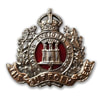2013 Friends News
2013 was a great year for the Friends. We organised our first major battlefield tour to the Western Front, helped out with many interesting regimental projects and saw Regimental Colours restored and returned home. Read all about 2013 in our old news postings below:
Merry Christmas Friends!
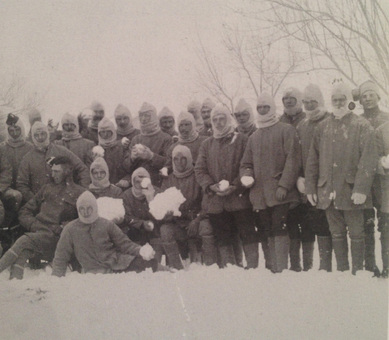
Merry Christmas Friends!
We hope you all have a happy, fun packed day with your families and friends - just like those members of 2nd Suffolk left, getting ready for a mammoth Christmas snowball fight (!) at Quetta in 1899.
Spare a thought today for all those men of the Regiment who, in two World Wars and other conflicts before and since, were on active service around the globe and who couldn't make it home to spend Christmas with their families.
(Posted: 25/12/2013)r
We hope you all have a happy, fun packed day with your families and friends - just like those members of 2nd Suffolk left, getting ready for a mammoth Christmas snowball fight (!) at Quetta in 1899.
Spare a thought today for all those men of the Regiment who, in two World Wars and other conflicts before and since, were on active service around the globe and who couldn't make it home to spend Christmas with their families.
(Posted: 25/12/2013)r
406510, 2/Lt. Ian Hendry, The Duke of York's Own Loyal Suffolk Hussars
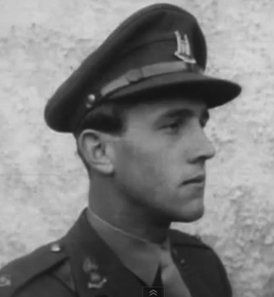
Today, whilst getting the labels printed to distribute the next edition of the Castle & Key, we came across the photograph left, of the noted British actor, Ian Hendry in the uniform of the Suffolk Yeomanry.
Hendry, famous for such films as The Hill (1965) and Get Carter (1971), was born in Ipswich in 1931 and educated at Culford School near Bury St. Edmunds; which throughout the Second World War, had strong Cadet Force associations to both the Suffolk Regiment and the Suffolk Yeomanry.
Hendry served out his two years of National Service (1949-1951) at Gordon Barracks Aberdeen, with 32nd Medium Regiment, Royal Artillery; who had only recently returned to the UK after serving in North West Europe.
The photograph, taken during his National Service, shows Hendry wearing the cap badge of the Loyal Suffolk Hussars, with the collar badges of the Royal Artillery, to whom the Regiment had converted to in the 1920s, swapping their horses for heavy guns.
Following this, he returned to a career as a Land Surveyor but by 1952, the stage was beckoning and he took a place that was offered to him at the Central School of Speech and Drama. After a busy career of over 30 years on stage, screen, TV and a life of excess, Hendry died age 53 in December 1984. He had three marriages, three driving bans and had been declared bankrupt. The Suffolk Yeoman with a gift for performance, was once described as the actor "who should have been a star."
With thanks to the official Ian Hendry website (www.ianhendry.com) for the above image.
(Posted: 21/12/2013)
Hendry, famous for such films as The Hill (1965) and Get Carter (1971), was born in Ipswich in 1931 and educated at Culford School near Bury St. Edmunds; which throughout the Second World War, had strong Cadet Force associations to both the Suffolk Regiment and the Suffolk Yeomanry.
Hendry served out his two years of National Service (1949-1951) at Gordon Barracks Aberdeen, with 32nd Medium Regiment, Royal Artillery; who had only recently returned to the UK after serving in North West Europe.
The photograph, taken during his National Service, shows Hendry wearing the cap badge of the Loyal Suffolk Hussars, with the collar badges of the Royal Artillery, to whom the Regiment had converted to in the 1920s, swapping their horses for heavy guns.
Following this, he returned to a career as a Land Surveyor but by 1952, the stage was beckoning and he took a place that was offered to him at the Central School of Speech and Drama. After a busy career of over 30 years on stage, screen, TV and a life of excess, Hendry died age 53 in December 1984. He had three marriages, three driving bans and had been declared bankrupt. The Suffolk Yeoman with a gift for performance, was once described as the actor "who should have been a star."
With thanks to the official Ian Hendry website (www.ianhendry.com) for the above image.
(Posted: 21/12/2013)
The Sad Loss Of Friend Ron Mace
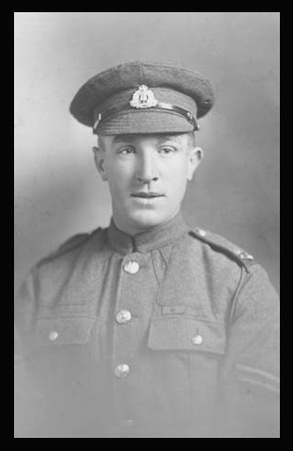
Today, we learnt of the sad news that Friend Ron Mace has passed away.
Ron was a great supporter of the Friends and for the past 10 years he had been planning with the aid of his very good friend, John Taylor, a fitting memorial to Sidney James Day VC, in his birth town of Norwich.
Sid Day, who was born in the city in 1891, in the now demolished St. Ann's Lane, won his Victoria Cross on 26th August 1917 at Hargicourt, near Peronne, whilst serving with the 11th (Service) Battalion, The Suffolk Regiment.
Although his original birthplace has now gone, Ron was trying desperately to get a permanent memorial to Sid Day before the Centenary of his winning the medal in 2017.
Many ideas and proposals were put forward, including the naming of a new road in his honour on the estate that now occupies the land where he was born, but alas this came to nothing.
Perhaps now with the government's new centenial scheme to place memorial stones to VC winners in Britain's pavements, Sid Day will finally get a lasting memorial in his home town.
However, Ron and Sid deserve much more than this and the Friends will do all that they can to see that Ron's dream of a fitting and honourable memorial to Sid Day, finally becomes a reality.
(Posted: 15/12/2013)
Ron was a great supporter of the Friends and for the past 10 years he had been planning with the aid of his very good friend, John Taylor, a fitting memorial to Sidney James Day VC, in his birth town of Norwich.
Sid Day, who was born in the city in 1891, in the now demolished St. Ann's Lane, won his Victoria Cross on 26th August 1917 at Hargicourt, near Peronne, whilst serving with the 11th (Service) Battalion, The Suffolk Regiment.
Although his original birthplace has now gone, Ron was trying desperately to get a permanent memorial to Sid Day before the Centenary of his winning the medal in 2017.
Many ideas and proposals were put forward, including the naming of a new road in his honour on the estate that now occupies the land where he was born, but alas this came to nothing.
Perhaps now with the government's new centenial scheme to place memorial stones to VC winners in Britain's pavements, Sid Day will finally get a lasting memorial in his home town.
However, Ron and Sid deserve much more than this and the Friends will do all that they can to see that Ron's dream of a fitting and honourable memorial to Sid Day, finally becomes a reality.
(Posted: 15/12/2013)
Remembering the Eureka Stockade
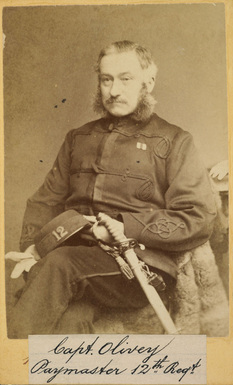
Today, December 3rd, sees the anniversary of the storming of the "Eureka Stockade" in Australia in 1853, an action in which the 12th (East Suffolk) Regiment played an important part.
In the 1850s, Australia was gripped by gold fever. The prospectors, who saw it as a natural right to the treasure that Australia possessed, were rebelling against the hefty licensing fees that the authorities were imposing on them to dig. When the rates increased, fractions became fraught and the prospectors banded together and formed themselves into armed settlements outside the jurisdiction of the authorities.
These settlements or 'stockades' as they became known, were springing up across Australia in alarming numbers. With a pitifully small civil force, the Governor appealed to Great Britain for armed assistance to deal with the riotous 'diggers,' and thus in October 1853, the 12th Regiment arrived in Australia to assist the civil powers.
In the brief action that followed that day, which resulted in the capture of the stockade and the seizing of the rebels unique flag; the "Crux Australis" or "Southern Cross," losses to the Regiment were one Drummer Boy and 3 Other Ranks. Their names are still inscribed upon a memorial at the spot of the former stockade, which records their actions that day in quashing an armed revolution, by what was a "band of aggrieved diggers in arms"
Left: Regimental Paymaster Walter Rice Olivey, 12th Regiment, circa 1866. His youngest son, Herbert, would be killed in Somaliland in April 1903, whilst serving with the King's African Rifles.
(Posted: 03/12/2013) (Amended: 21/05/2020 - with thanks to the relatives of Walter Olivey)
In the 1850s, Australia was gripped by gold fever. The prospectors, who saw it as a natural right to the treasure that Australia possessed, were rebelling against the hefty licensing fees that the authorities were imposing on them to dig. When the rates increased, fractions became fraught and the prospectors banded together and formed themselves into armed settlements outside the jurisdiction of the authorities.
These settlements or 'stockades' as they became known, were springing up across Australia in alarming numbers. With a pitifully small civil force, the Governor appealed to Great Britain for armed assistance to deal with the riotous 'diggers,' and thus in October 1853, the 12th Regiment arrived in Australia to assist the civil powers.
In the brief action that followed that day, which resulted in the capture of the stockade and the seizing of the rebels unique flag; the "Crux Australis" or "Southern Cross," losses to the Regiment were one Drummer Boy and 3 Other Ranks. Their names are still inscribed upon a memorial at the spot of the former stockade, which records their actions that day in quashing an armed revolution, by what was a "band of aggrieved diggers in arms"
Left: Regimental Paymaster Walter Rice Olivey, 12th Regiment, circa 1866. His youngest son, Herbert, would be killed in Somaliland in April 1903, whilst serving with the King's African Rifles.
(Posted: 03/12/2013) (Amended: 21/05/2020 - with thanks to the relatives of Walter Olivey)
Long Melford Seeks Help With Centenary Project
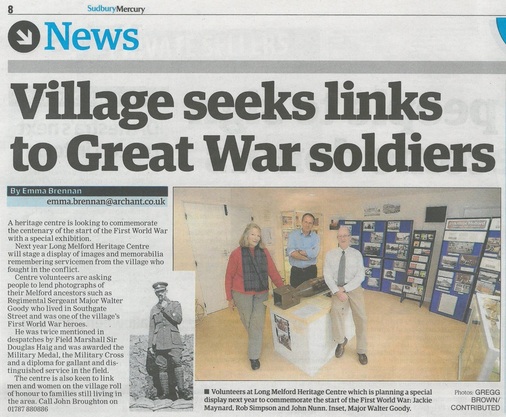
Back in September, The Friends were contacted by John Nunn of the Long Melford Heritage Centre, regarding information on the men on the villages' War Memorial and in particular, of RSM Walter Goody MC, MM, OLII (Military Cross, Military Medal, Order of Leopold II (Belgium)), who was killed serving with 7/Suffolk west of Albert, in April 1918.
By a quirk of fate, Taff was giving a talk in April to the Thames Valley Branch of the Western Front Association, where he was approached by a lady whose husband was the grandson of RSM Goody. Taff was able to provide her with a photograph of him in his Suffolk Regiment uniform and a little bit of information on him and the life of the 7th Battalion.
We since learn that the project is picking up pace and that a special exhibition is planned for next year. The clipping (left), from the Sudbury Mercury, shows John and his team at the Centre, and inset is the very same photograph of RSM Goody from the Gillingham archives.
If anyone can help the Heritage Centre with their endeavours about a soldier on the Long Melford memorial, please do get in contact with us in the usual ways. The list of those commemorated can be found here at the excellent 'Roll of Honour' website: http://www.roll-of-honour.com/Suffolk/LongMelford.html
(Posted: 21/11/2013)
By a quirk of fate, Taff was giving a talk in April to the Thames Valley Branch of the Western Front Association, where he was approached by a lady whose husband was the grandson of RSM Goody. Taff was able to provide her with a photograph of him in his Suffolk Regiment uniform and a little bit of information on him and the life of the 7th Battalion.
We since learn that the project is picking up pace and that a special exhibition is planned for next year. The clipping (left), from the Sudbury Mercury, shows John and his team at the Centre, and inset is the very same photograph of RSM Goody from the Gillingham archives.
If anyone can help the Heritage Centre with their endeavours about a soldier on the Long Melford memorial, please do get in contact with us in the usual ways. The list of those commemorated can be found here at the excellent 'Roll of Honour' website: http://www.roll-of-honour.com/Suffolk/LongMelford.html
(Posted: 21/11/2013)
We Will Remember Them
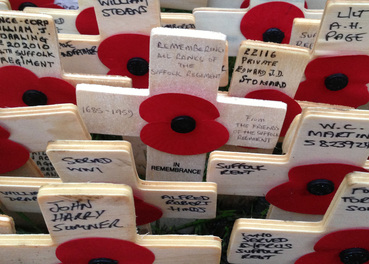
The Friends were in London today as guests of the Western Front Association, who each year, hold a service of remembrance at The Cenotaph at 11.00am on 11th November.
Following the service, we walked to the Field of Remembrance near Westminster Abbey to plant a Memorial Cross to remember all those of The Suffolk Regiment who have died on active service since it's formation in 1685.
It was poignant to see the Suffolk Regiment plot full with crosses; proof that even today, 54 years after it's amalgamation, it's members are definitely not forgotten.
(Posted: 11/11/2013)
Following the service, we walked to the Field of Remembrance near Westminster Abbey to plant a Memorial Cross to remember all those of The Suffolk Regiment who have died on active service since it's formation in 1685.
It was poignant to see the Suffolk Regiment plot full with crosses; proof that even today, 54 years after it's amalgamation, it's members are definitely not forgotten.
(Posted: 11/11/2013)
Lest We Forget...
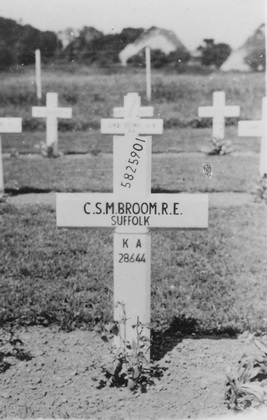
Today, Remembrance Sunday, Her Majesty The Queen, leads the Nation in our annual act of commemoration to remember the dead of two World Wars and other subsequent conflicts since.
At Cenotaphs and War Memorials across the country and across all the World, grateful nations pause to remember those who died on active service for "The Sacred Cause of Justice and the Freedom of the World" - so is carved the inscription on the Tomb of the Unknown Warrior in Westminster Abbey.
Next year, 100 years after the outbreak of the Great War, remembrance will be widespread in the nations media. However, today and tomorrow on Armistice Day, spare a though for the 8531 men of The Suffolk Regiment and the 1628 men of The Cambridgeshire Regiment who lost their lives on active service in conflicts since 1914.
Although amalgamated in 1959 and 1961, the men of these Regiments are not forgotten by the Friends. We will remember them today, tomorrow and always.
(Posted: 10/11/2013)
The grave above of CSM 'Ted' Broom in Hermanville Military Cemetery, Normandy, is reproduced with kind permission of his nephew, George Flory. CSM Broom was killed with 1/Suffolk at the Chateau de la Londe in June 1944, and George completed his National Service with 1/Suffolk in Malaya.
At Cenotaphs and War Memorials across the country and across all the World, grateful nations pause to remember those who died on active service for "The Sacred Cause of Justice and the Freedom of the World" - so is carved the inscription on the Tomb of the Unknown Warrior in Westminster Abbey.
Next year, 100 years after the outbreak of the Great War, remembrance will be widespread in the nations media. However, today and tomorrow on Armistice Day, spare a though for the 8531 men of The Suffolk Regiment and the 1628 men of The Cambridgeshire Regiment who lost their lives on active service in conflicts since 1914.
Although amalgamated in 1959 and 1961, the men of these Regiments are not forgotten by the Friends. We will remember them today, tomorrow and always.
(Posted: 10/11/2013)
The grave above of CSM 'Ted' Broom in Hermanville Military Cemetery, Normandy, is reproduced with kind permission of his nephew, George Flory. CSM Broom was killed with 1/Suffolk at the Chateau de la Londe in June 1944, and George completed his National Service with 1/Suffolk in Malaya.
Live...From The Suffolk Regiment Museum
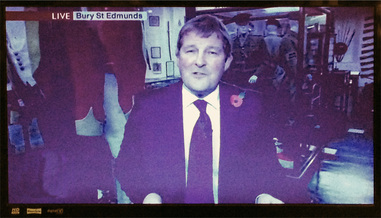
Tonight on BBC 'Look East' news, presenter Kim Reilly reported live from the Suffolk Regiment Museum about the decline of Royal British Legion Clubs across East Anglia.
In a series of short cut-away shots, Kim stood amidst the array of amazing artefacts from our proud past, whilst interviewing the Mayor of Bury St. Edmunds.
Still not visited yet? well, what are you waiting for? (!)
(Posted: 09/11/2013)
In a series of short cut-away shots, Kim stood amidst the array of amazing artefacts from our proud past, whilst interviewing the Mayor of Bury St. Edmunds.
Still not visited yet? well, what are you waiting for? (!)
(Posted: 09/11/2013)
The Heal Family Archive
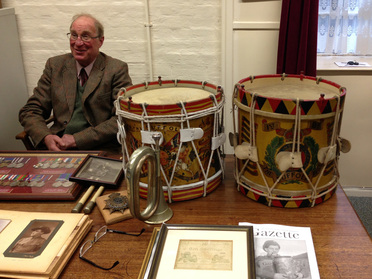
Today, the Friends were invited to the Regimental Museum to meet with William Heal, the son of the late Lieutenant-Colonel W.A. Heal, OBE, Commanding Officer of the 1st Battalion (1953-56) who brought along his father's souvenirs of his time with The Suffolk Regiment to show us.
William brought two drums, one dating from around 1906, a presentation bugle and numerous photographs for us to see. The items spanned four generations of the Heal family's military service.
Colonel 'Tiny' was commissioned into The Suffolk Regiment in 1931, becoming Adjutant of the 1st Battalion at the time of the retreat to Dunkirk. Later transferred to the Essex Regiment, he re-joined the 1st Battalion in Malaya in 1949.
When the Battalion was posted to Trieste in 1953, he became their Commanding Officer. Remaining CO until 1956, when the Battalion returned to Colchester from Germany; where they had been stationed since 1954. He was succeeded as CO in 1956 by Lieutenant-Colonel W.S. Bevan.
Colonel Tiny's father served in the Boer War as part of the 43rd (Suffolk) Company, Imperial Yeomanry and the Loyal Suffolk Hussars. He later went on to command the South African Brigade during the Great War. William himself served in Northern Ireland with The Royal Anglian Regiment.
A great day out at Suffolk's best museum and a great chance to see a unique collection of Suffolk Regiment related memorabilia.
(Posted: 06/11/2013)
William brought two drums, one dating from around 1906, a presentation bugle and numerous photographs for us to see. The items spanned four generations of the Heal family's military service.
Colonel 'Tiny' was commissioned into The Suffolk Regiment in 1931, becoming Adjutant of the 1st Battalion at the time of the retreat to Dunkirk. Later transferred to the Essex Regiment, he re-joined the 1st Battalion in Malaya in 1949.
When the Battalion was posted to Trieste in 1953, he became their Commanding Officer. Remaining CO until 1956, when the Battalion returned to Colchester from Germany; where they had been stationed since 1954. He was succeeded as CO in 1956 by Lieutenant-Colonel W.S. Bevan.
Colonel Tiny's father served in the Boer War as part of the 43rd (Suffolk) Company, Imperial Yeomanry and the Loyal Suffolk Hussars. He later went on to command the South African Brigade during the Great War. William himself served in Northern Ireland with The Royal Anglian Regiment.
A great day out at Suffolk's best museum and a great chance to see a unique collection of Suffolk Regiment related memorabilia.
(Posted: 06/11/2013)
Photos of Taff's NS Talk Appear in Britain At War
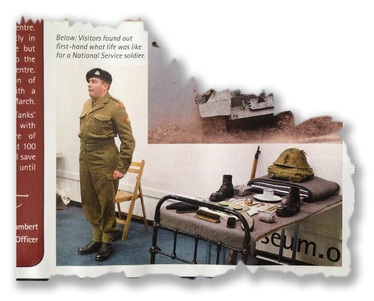
Back in September, we told you of Taff's talk at the Tank Museum in Dorset about A Day in the Life of a National Service Soldier. Little did we know that lurking in the audience was a reporter from 'Britain at War' magazine.
A photograph of a slightly "disheveled" Mark has just appeared in the November edition of the magazine (left) sporting original Suffolk Regiment National Service period uniform and insignia.
However it must stated that the talk was designed to illustrate the first few days of a recruits 'Basic Training', and it should never be assumed that any fully trained Suffolk Regiment National Serviceman would have ever got outside the Barrack Gate looking as bad as this!
(Posted: 2/11/2013)
A photograph of a slightly "disheveled" Mark has just appeared in the November edition of the magazine (left) sporting original Suffolk Regiment National Service period uniform and insignia.
However it must stated that the talk was designed to illustrate the first few days of a recruits 'Basic Training', and it should never be assumed that any fully trained Suffolk Regiment National Serviceman would have ever got outside the Barrack Gate looking as bad as this!
(Posted: 2/11/2013)
Fred Braysher, 1st Suffolk (1906 - 1914)
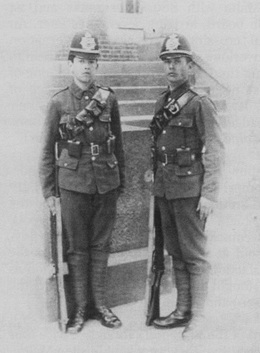
Friend Robin Braysher has recently written an excellent series of articles on his grandfather; Fred Braysher, in the September edition of "The New Mosquito" the bi-annual newsletter of the Salonika Campaign Society.
Fred's career with the Suffolk Regiment started in 1906, with a brief spell in the 4th Battalion, before being posted to the 1st Battalion, then stationed at Cambridge Barracks, Woolwich.
From 1907 until 1911, he served in Malta, being a keen athlete, swimmer and knitter! He later went with the Battalion to Egypt where they were stationed at Khartoum.
Fred left the Regiment in December 1914 to volunteer to join the 28th Divisional Cyclist's Company that were in due course, to be sent to the Salonika front, where his old Regiment; 1st Suffolk would soon also be posted.
You can read Fred's story in full, which is profusely illustrated with excellent photographs - such as Fred and a chum at Woolwich wearing Khaki serge and Home Service helmets (shown left), by joining this fantastic and friendly little society; full details of which can be found at the following address:
www.salonikacampaignsociety.org.uk
(Posted: 27/10/2013)
Photograph above, courtesy of Robin Braysher
Fred's career with the Suffolk Regiment started in 1906, with a brief spell in the 4th Battalion, before being posted to the 1st Battalion, then stationed at Cambridge Barracks, Woolwich.
From 1907 until 1911, he served in Malta, being a keen athlete, swimmer and knitter! He later went with the Battalion to Egypt where they were stationed at Khartoum.
Fred left the Regiment in December 1914 to volunteer to join the 28th Divisional Cyclist's Company that were in due course, to be sent to the Salonika front, where his old Regiment; 1st Suffolk would soon also be posted.
You can read Fred's story in full, which is profusely illustrated with excellent photographs - such as Fred and a chum at Woolwich wearing Khaki serge and Home Service helmets (shown left), by joining this fantastic and friendly little society; full details of which can be found at the following address:
www.salonikacampaignsociety.org.uk
(Posted: 27/10/2013)
Photograph above, courtesy of Robin Braysher
Colonel Dick's Rolex?
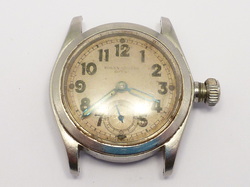
Just ended on eBay is a Rolex 'Oyster Royal' wristwatch. Not working and in need of restoration, it is nothing unusual and probably only good for spares. However what makes this watch potentially something special, is that it is engraved on the back - “R.E. Goodwin” - could it be Lieutenant-Colonel Dick Goodwin’s wristwatch?
It is of the correct period and carries a service date on the inside of the case of 2/8/1947 so it would almost certainly date from his time in the Regiment – but is it his?
We have, over the last week, searched in vain to find a photograph of him wearing any form of wristwatch, but frustratingly every photo we’ve found of him, shows him with either his hands crossed or held behind his back. We thought we might be onto a winner with the photograph taken in 1944 with Monty and the other senior decorated officers of 3rd Infantry Division after he had just been awarded the DSO, but frustratingly he's wearing gloves!
It is of the correct period and carries a service date on the inside of the case of 2/8/1947 so it would almost certainly date from his time in the Regiment – but is it his?
We have, over the last week, searched in vain to find a photograph of him wearing any form of wristwatch, but frustratingly every photo we’ve found of him, shows him with either his hands crossed or held behind his back. We thought we might be onto a winner with the photograph taken in 1944 with Monty and the other senior decorated officers of 3rd Infantry Division after he had just been awarded the DSO, but frustratingly he's wearing gloves!
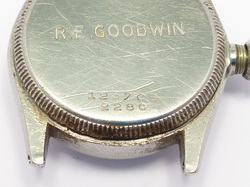
Commissioned into the Suffolk Regiment in 1929, Richard Elton Goodwin rose through the Suffolk Regiment to be appointed Commanding Officer of the 1st Battalion in 1943. It was under his leadership that the Battalion
trained to become the Senior Battalion in 8 Brigade, 3rd (British) Division; culminating in their taking a pivotal role in the D-Day landings and the capturing of the bunker complex codenamed "Hillman" on the afternoon of D-Day itself.
Wounded on D+2, after his recovery, he returned to the Battalion in November 1944, to lead it through Holland to Bremen, where 1/Suffolk ended the war.
He was later given command of a Brigade and after appointments at the Staff College and the School of Infantry, he ended his career as Lieutenant-General Sir R.E. Goodwin, KCB, CBE, DSO, in 1969. We are unsure as to who the new owner of the watch is, but if it is Colonel Dick's watch, we hope they will appreciate what amazing moments of Regimental History this timepiece has seen and that they will give it a treasured home.
(Posted: 24/10/2013)
Wounded on D+2, after his recovery, he returned to the Battalion in November 1944, to lead it through Holland to Bremen, where 1/Suffolk ended the war.
He was later given command of a Brigade and after appointments at the Staff College and the School of Infantry, he ended his career as Lieutenant-General Sir R.E. Goodwin, KCB, CBE, DSO, in 1969. We are unsure as to who the new owner of the watch is, but if it is Colonel Dick's watch, we hope they will appreciate what amazing moments of Regimental History this timepiece has seen and that they will give it a treasured home.
(Posted: 24/10/2013)
Struggling For A Christmas Present?
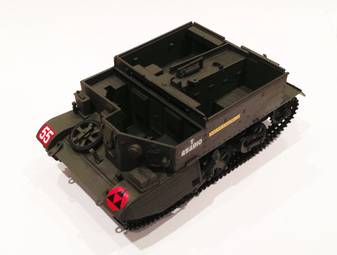
It's that time of year again where the shops are beginning to be filled with Christmas merchandise, but just what sort of present do you buy that special Suffolk Regiment person for Christmas?
Many online sites will sell you a wealth of cheap cap-badge-adorned object d'art but for those with a creative leaning, how about a model kit?
Tamiya do an excellent Universal Carrier (product code MM 175) which can be finished in 3rd Infantry Division livery, right down to the Battalion identification number "55" for the nearside mudguards.
For those 'advanced' modellers wishing to go a stage further, they will need to print off their own nameplates for the side of the carrier and glue them on themselves (nearly all 1/Suffolk carriers were either named after Battle Honours or Suffolk places).
We chose "Neuve Chapelle" since there are some excellent original colour photographs of it at Weert, Holland in September 1944; complete with petrol tins, tarpaulins and biscuit tin 'Benghazi cookers' (see Castle & Key No. 5).
Those wishing to get hold of a carrier model can find them online and at any good old-fashioned model shop. They usually retail for around £15.00, so before you step out to buy a gaudy tie or some musical socks, think about a model instead.
Paint, paint brushes and a steady hand (which you will need!) are not included in the kit!
(Posted: 06/10/2013)
Many online sites will sell you a wealth of cheap cap-badge-adorned object d'art but for those with a creative leaning, how about a model kit?
Tamiya do an excellent Universal Carrier (product code MM 175) which can be finished in 3rd Infantry Division livery, right down to the Battalion identification number "55" for the nearside mudguards.
For those 'advanced' modellers wishing to go a stage further, they will need to print off their own nameplates for the side of the carrier and glue them on themselves (nearly all 1/Suffolk carriers were either named after Battle Honours or Suffolk places).
We chose "Neuve Chapelle" since there are some excellent original colour photographs of it at Weert, Holland in September 1944; complete with petrol tins, tarpaulins and biscuit tin 'Benghazi cookers' (see Castle & Key No. 5).
Those wishing to get hold of a carrier model can find them online and at any good old-fashioned model shop. They usually retail for around £15.00, so before you step out to buy a gaudy tie or some musical socks, think about a model instead.
Paint, paint brushes and a steady hand (which you will need!) are not included in the kit!
(Posted: 06/10/2013)
7/Suffolk On The Jurassic Coast: 1941
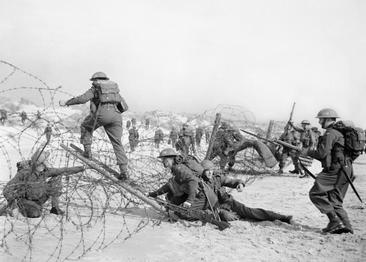
On Saturday, Taff was talking at the Tank Museum in Dorset. His talk, entitled "A Day In the Life Of A National Service Soldier," took the audience from reveille at 6.00am to lights-out at 10.00pm and everything else in between!
On the way home, we decided, since it wasn't that far away, to take a small detour to Studland Bay, near Swanage; home in 1941, to the 7th Battalion, The Suffolk Regiment.
7/Suffolk, known at the time as "the string and cardboard Suffolks" - on account that there were not enough service respirators to go around, and many men still carried their civilian gas masks! were stationed in Studland, being engaged in front line defence duties guarding the flat sandy beaches on the southern side of the entrance to Poole harbour; a prime invasion spot for a German sea-borne invasion.
In late 1941, having trained as infantry for over 12 months, they moved west from Studland, to Bovingdon Camp to be converted to an armoured unit; 142 Regiment, R.A.C., soon to be posted to North Africa and then onto Italy. However, despite their short stay in Dorset, they left their mark on Studland, namely in the form of a section of slit trenches on the cliffs edge which can still (just) be seen today.
The land upon which they sit, is owned by the Knoll House Hotel and in the 1980s, they erected a small plaque to mark the spot. We'd always wanted to go back to see the spot since Taff first heard of it in the early 1990s, and its just as well that we did, as in a few years, the trenches will have disappeared into the sea. The hotel has a photograph of a Company of the Battalion, when they were billeted in the hotel, which they kindly allowed us to copy, so in the next Castle & Key, there will be a special, double edition of "The Camera Returns" featuring 7/Suffolk on the Jurassic coast - so look out for it!
Photograph above of 7/Suffolk on exercise at Studland, courtesy of the Imperial War Museum (H8393).
(Posted: 23/09/2013)
On the way home, we decided, since it wasn't that far away, to take a small detour to Studland Bay, near Swanage; home in 1941, to the 7th Battalion, The Suffolk Regiment.
7/Suffolk, known at the time as "the string and cardboard Suffolks" - on account that there were not enough service respirators to go around, and many men still carried their civilian gas masks! were stationed in Studland, being engaged in front line defence duties guarding the flat sandy beaches on the southern side of the entrance to Poole harbour; a prime invasion spot for a German sea-borne invasion.
In late 1941, having trained as infantry for over 12 months, they moved west from Studland, to Bovingdon Camp to be converted to an armoured unit; 142 Regiment, R.A.C., soon to be posted to North Africa and then onto Italy. However, despite their short stay in Dorset, they left their mark on Studland, namely in the form of a section of slit trenches on the cliffs edge which can still (just) be seen today.
The land upon which they sit, is owned by the Knoll House Hotel and in the 1980s, they erected a small plaque to mark the spot. We'd always wanted to go back to see the spot since Taff first heard of it in the early 1990s, and its just as well that we did, as in a few years, the trenches will have disappeared into the sea. The hotel has a photograph of a Company of the Battalion, when they were billeted in the hotel, which they kindly allowed us to copy, so in the next Castle & Key, there will be a special, double edition of "The Camera Returns" featuring 7/Suffolk on the Jurassic coast - so look out for it!
Photograph above of 7/Suffolk on exercise at Studland, courtesy of the Imperial War Museum (H8393).
(Posted: 23/09/2013)
First Friends Battlefield Tour - We're Back!
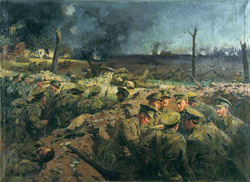
We're back in 'blighty' after an action packed, but very moving, four-day tour to the former battlefields of the Western Front. To see what you missed including returning to the exact spot where Fred Roe's famous picture was actually sketched - check out the 2013 tour page for a brief write-up. A fuller, more detailed account will be in the next Castle & Key.
(Posted: 02/09/2013)
(Posted: 02/09/2013)
First Friends Battlefield Tour - We're Off!
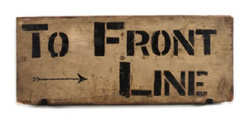
After months of planning, the first Friends battlefield tour is finally a reality. A small group of Friends are off for a four-day tour to the Western Front. Taking in the Ypres Salient, Le Cateau, Neuve Chapelle, Arras, Cambrai, Loos and the Somme, it will be an informative and interesting few days.
A full report will be published in the next Castle & Key, due in the Autumn.
(Posted: 21/08/2013)
A full report will be published in the next Castle & Key, due in the Autumn.
(Posted: 21/08/2013)
Restored Colours Of The 3rd Battalion Finally Returned To Ickworth Church
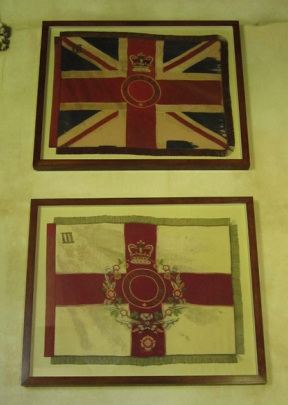
Finally, after an extensive three-year restoration, the Colours of the 3rd (Militia) Battalion, have returned to their rightful resting place in the Church of St. Mary's, Ickworth Suffolk.
The Colours, presented in 1878, by the Marchioness of Bristol, were laid up on 25th May 1912, after a new Stand of Colours were presented to the Battalion at Bury St. Edmunds. They hung above the crypt of the late Marquis of Bristol, who had been Honorary Colonel of the Battalion, until the church fell into disuse in the late 1970s.
In late 2010, they were removed from the church is a sorry and extremely fragile condition, having been hung un-netted on their original poles since they were originally placed there. Open to the elements, due to a leaking roof, they had suffered considerably. It was therefore agreed that in co-operation with the Regimental Museum, they would be preserved and framed and returned to the church when it was restored.
The Colours are unique in the Regiment; in that they are the only stand of Colours presented to a Suffolk Battalion under the Cardwell Reforms of the 1880s. The Regimental Colour was of a new style which was not backed in the colour of the facings of the Regiment, but instead in an effort to make uniformity within the army, it was backed in the Cross of St. George. These Colours too, were the first to carry the new designation of "The Suffolk Regiment."
Conservation of the church is now proceeding well and after much restoration, the remains of these Colours were returned to the church last month, where they belong. The framed Colours now hang there once more for all to see.
(Posted: 07/08/2013)
The Colours, presented in 1878, by the Marchioness of Bristol, were laid up on 25th May 1912, after a new Stand of Colours were presented to the Battalion at Bury St. Edmunds. They hung above the crypt of the late Marquis of Bristol, who had been Honorary Colonel of the Battalion, until the church fell into disuse in the late 1970s.
In late 2010, they were removed from the church is a sorry and extremely fragile condition, having been hung un-netted on their original poles since they were originally placed there. Open to the elements, due to a leaking roof, they had suffered considerably. It was therefore agreed that in co-operation with the Regimental Museum, they would be preserved and framed and returned to the church when it was restored.
The Colours are unique in the Regiment; in that they are the only stand of Colours presented to a Suffolk Battalion under the Cardwell Reforms of the 1880s. The Regimental Colour was of a new style which was not backed in the colour of the facings of the Regiment, but instead in an effort to make uniformity within the army, it was backed in the Cross of St. George. These Colours too, were the first to carry the new designation of "The Suffolk Regiment."
Conservation of the church is now proceeding well and after much restoration, the remains of these Colours were returned to the church last month, where they belong. The framed Colours now hang there once more for all to see.
(Posted: 07/08/2013)
Minden Day 2013 - A Great Success!
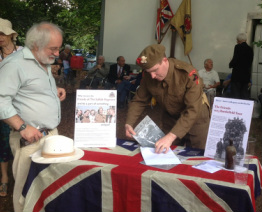
Minden Day 2013 was as always, a great success. The annual Regimental reunion of The Suffolk Regiment, passed superbly with everyone attending, enjoying a fantastic day.
It was great to see many old and new faces attending this years event. New Friends joining us were slightly down on last year, but we're still a very healthy organisation. The ladies of the Ipswich and District Suffolk Regiment Old Comrades, worked tirelessly to keep up the flow of endless cups of tea and refreshments. High praise is due to Tracey, Marion and Jackie for their sterling work; thank you ladies!
Despite the original parade ground being greatly diminished by the newly erected buildings of West Suffolk College, the Band of the Royal Engineers, did the Regiment proud by playing in its entirety, the Regimental March "Speed the Plough" which hadn't been heard for many years. The many branches of the Old Comrades Association marched with their branch standards along with many friends from neighbouring counties; The Royal Norfolk's and the Beds and Herts.
The museum had a busy day as always, with many new and interesting items being donated and it was excellent to see the Colour Party from 1/Royal Anglian Regiment with their Colours suitable decked with wreaths of red and yellow roses. Next year will we hope, be even better; make sure you put it in you diaries now - Sunday 3rd August 2014.
Above: A new Friend being signed up on Sunday.
(Posted: 07/08/2013)
It was great to see many old and new faces attending this years event. New Friends joining us were slightly down on last year, but we're still a very healthy organisation. The ladies of the Ipswich and District Suffolk Regiment Old Comrades, worked tirelessly to keep up the flow of endless cups of tea and refreshments. High praise is due to Tracey, Marion and Jackie for their sterling work; thank you ladies!
Despite the original parade ground being greatly diminished by the newly erected buildings of West Suffolk College, the Band of the Royal Engineers, did the Regiment proud by playing in its entirety, the Regimental March "Speed the Plough" which hadn't been heard for many years. The many branches of the Old Comrades Association marched with their branch standards along with many friends from neighbouring counties; The Royal Norfolk's and the Beds and Herts.
The museum had a busy day as always, with many new and interesting items being donated and it was excellent to see the Colour Party from 1/Royal Anglian Regiment with their Colours suitable decked with wreaths of red and yellow roses. Next year will we hope, be even better; make sure you put it in you diaries now - Sunday 3rd August 2014.
Above: A new Friend being signed up on Sunday.
(Posted: 07/08/2013)
The Depot - A View From The Other Side Of The Barrack Wall!
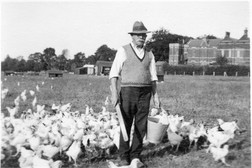
Yes, we understand that you probably think we are quite mad showing you a picture of a man feeding his chickens, however this photograph is something a little bit special.
Following our appeal a couple of months back for photographs of Gibraltar Barracks, we were sent a link to a page on Ancestry, the family history website, of William Diss, formerly of the Suffolk Regiment (service in the Boer War and the Great War) in his retirement, feeding chickens in a field on the outskirts of Bury St. Edmunds. However what made this photograph special was what was in the background - The Depot.
The building seen is the hospital block, with its separate external spiral stone staircase - seen on the rear corner of the building behind William's left shoulder. To it's left, over Williams other shoulder, is the "Infectious Ward" where those with threatening illnesses were quarantined, but where is the barrack wall?
The wall, which was over 10ft. high, was part of the original Depot site built in 1878, but it is clearly absent in this photograph, unless the small hedge which bordered the roadway (which ran along the rear of the building) is taller than we think. Maybe the wall was demolished only to be rebuilt later? Who knows? The date given for the photograph is 1936 so we're all in a little bit of a muddle on this. Someone please help us out if you can!
(Posted: 09/05/2013)
Following our appeal a couple of months back for photographs of Gibraltar Barracks, we were sent a link to a page on Ancestry, the family history website, of William Diss, formerly of the Suffolk Regiment (service in the Boer War and the Great War) in his retirement, feeding chickens in a field on the outskirts of Bury St. Edmunds. However what made this photograph special was what was in the background - The Depot.
The building seen is the hospital block, with its separate external spiral stone staircase - seen on the rear corner of the building behind William's left shoulder. To it's left, over Williams other shoulder, is the "Infectious Ward" where those with threatening illnesses were quarantined, but where is the barrack wall?
The wall, which was over 10ft. high, was part of the original Depot site built in 1878, but it is clearly absent in this photograph, unless the small hedge which bordered the roadway (which ran along the rear of the building) is taller than we think. Maybe the wall was demolished only to be rebuilt later? Who knows? The date given for the photograph is 1936 so we're all in a little bit of a muddle on this. Someone please help us out if you can!
(Posted: 09/05/2013)
New 12th Regiment Prints Come To Light
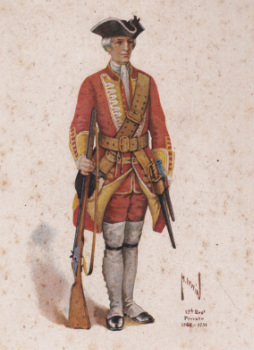
Recently we were given a set of three rather battered and faded prints of members of the 12th Regiment of Foot, c.1750. The glass in the frame was missing and the dreaded beetle had started to munch away at the prints, yet despite all of this, they were still worth saving.
At first, we believed these to be three figures from a series of postcards commissioned by the Regiment in 1935 to celebrate it's 250th Anniversary. However as we split the frame to get the prints out, we noticed an original framing label dated 1913 from the Army and Navy Co-operative Company, so they pre-dated the 1935 prints by almost 25 years.
There all a bit of mystery to us as although several prints and engravings depicting the uniforms of this period are known to us, we've never come across these. We did a quick check for the artist "M. Iywin," but this had produced nothing as yet. We thought at first, that they may have been commissioned for the first volume of Regimental History published in 1913, however this is not so. Therefore, we throwing this out to the wider world to see if any of our members have any more information on the series. Are there more or is it just these three? If you have any further information on them, we'd like to hear from you!
(Posted: 03/05/2013)
At first, we believed these to be three figures from a series of postcards commissioned by the Regiment in 1935 to celebrate it's 250th Anniversary. However as we split the frame to get the prints out, we noticed an original framing label dated 1913 from the Army and Navy Co-operative Company, so they pre-dated the 1935 prints by almost 25 years.
There all a bit of mystery to us as although several prints and engravings depicting the uniforms of this period are known to us, we've never come across these. We did a quick check for the artist "M. Iywin," but this had produced nothing as yet. We thought at first, that they may have been commissioned for the first volume of Regimental History published in 1913, however this is not so. Therefore, we throwing this out to the wider world to see if any of our members have any more information on the series. Are there more or is it just these three? If you have any further information on them, we'd like to hear from you!
(Posted: 03/05/2013)
Daffodil Sunday - Regretfully Cancelled
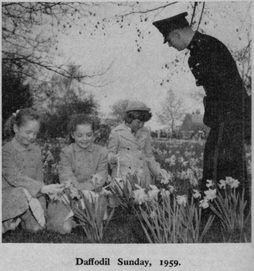
For the eagle-eyed amongst us, you will have noticed that we have not mentioned Daffodil Sunday this year. The reason for this is simple; the weather!
It was fair to say that late March and early April were about the bleakest and coldest since records began and, on the day we proposed to open the former Depot site to the public, the daffodil bulbs were covered with four inches of snow. These bulbs; originally planted in the 1930s, were yet to appear and rather than risk ridicule, we regretfully decided that we'd have to call-off the event this year.
Daffodil Sunday was traditionally the day when the Depot gates were opened to the people of Suffolk to come and see how their county regiment operated, and today, the Friends and the Regimental Museum keep this traditional alive.
Hopefully next year, we'll be having a better Springtime which will allow us once again throw open the barrack gates to you all to celebrate Daffodil Sunday in all its usual splendour. However, now that the weather is much milder, what better way to while away a Sunday than by visiting the excellent Regimental Museum at Gibraltar Barracks; the grounds of which will by now, be awash with those beautiful yellow Daffodils!
(Posted: 18/04/2013)
It was fair to say that late March and early April were about the bleakest and coldest since records began and, on the day we proposed to open the former Depot site to the public, the daffodil bulbs were covered with four inches of snow. These bulbs; originally planted in the 1930s, were yet to appear and rather than risk ridicule, we regretfully decided that we'd have to call-off the event this year.
Daffodil Sunday was traditionally the day when the Depot gates were opened to the people of Suffolk to come and see how their county regiment operated, and today, the Friends and the Regimental Museum keep this traditional alive.
Hopefully next year, we'll be having a better Springtime which will allow us once again throw open the barrack gates to you all to celebrate Daffodil Sunday in all its usual splendour. However, now that the weather is much milder, what better way to while away a Sunday than by visiting the excellent Regimental Museum at Gibraltar Barracks; the grounds of which will by now, be awash with those beautiful yellow Daffodils!
(Posted: 18/04/2013)
IWM Photograph; B Company in Malaya - Can You Help?
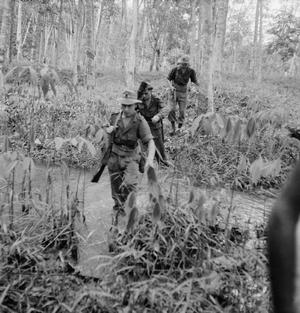
Since the launch of their new website last year, the Imperial War Museum (IWM) have gradually been making all their photographic collections digital to make them available for viewing online.
In the last batch of new pictures that were uploaded yesterday, was the image on the left, captioned as "Soldiers of the 1st Battalion, the Suffolk Regiment (possibly C Company) cross a stream in the middle of a jungle swamp whilst on a patrol during the Malayan Emergency." (1951)
This is great for us - another unknown Suffolk Regiment Malayan Emergency picture; but who are they? We can tell that they are not C Company as the men at the front and rear quite clearly have the B Company shields on their jungle hats, but apart from this, we have drawn a blank.
We'd like to know who they are and where the photograph was taken - can any of our members who served with B Company help us?
Any assistance, no matter how small, will as always, be greatly appreciated. You can contact us in the usual ways via the website or by telephone. Please Note: The picture can be made bigger by double clicking on it. We look forward to hearing from you! Image courtesy IWM (Ref BF 10373)
(Posted: 16/03/2013)
UPDATE: 18/04/2013 - With the assistance of Fred Mullender, formerly of 4 Platoon, B Company (aka "The Angels") we believe the lead man crossing the stream is a Private Murphy (or possibly Murray?) but if anyone can confirm this, we'd be very grateful.
In the last batch of new pictures that were uploaded yesterday, was the image on the left, captioned as "Soldiers of the 1st Battalion, the Suffolk Regiment (possibly C Company) cross a stream in the middle of a jungle swamp whilst on a patrol during the Malayan Emergency." (1951)
This is great for us - another unknown Suffolk Regiment Malayan Emergency picture; but who are they? We can tell that they are not C Company as the men at the front and rear quite clearly have the B Company shields on their jungle hats, but apart from this, we have drawn a blank.
We'd like to know who they are and where the photograph was taken - can any of our members who served with B Company help us?
Any assistance, no matter how small, will as always, be greatly appreciated. You can contact us in the usual ways via the website or by telephone. Please Note: The picture can be made bigger by double clicking on it. We look forward to hearing from you! Image courtesy IWM (Ref BF 10373)
(Posted: 16/03/2013)
UPDATE: 18/04/2013 - With the assistance of Fred Mullender, formerly of 4 Platoon, B Company (aka "The Angels") we believe the lead man crossing the stream is a Private Murphy (or possibly Murray?) but if anyone can confirm this, we'd be very grateful.
Officers Mess, Gibraltar Barracks - The Only Known Picture?
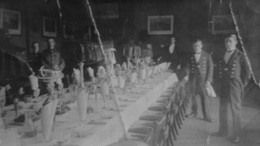
We recently attended the 'Who Do You Think You Are' Live event at Olympia with the Western Front Association and all weekend we were inundated with people look for help in identifying their families photographs.
On the Saturday morning, a delightful lady and her husband journeyed across to the stand to show us a well polished trio of Great War medals and a few photographs. As we turned over the 1914 Star, we saw 'SUFF.' on the back and our hearts lifted. The group and pictures belonged to a senior Sergeant of 2nd Suffolk captured at Le Cateau who was later imprisoned in Doeberlitz PoW camp. Sadly none of the photographs showed anything that could identify him as such but the above photograph shone out as being something special; a fully laid out table in the Officers Mess at Gibraltar Barracks, Bury St. Edmunds.
How did we know it was such? well, above the door are the two water-colours of the Kaffir Wars that now hang in the Regimental Museum and upon the table is the solid silver 'Gib' castle ashtray which is we believe, with our descendants; The Royal Anglian Regiment. What is also remarkable is that this is the first picture we have seen of the Mess Waiters in all their finery. The museum has an original Mess Waiters tail coat with its lavish silver buttons but we'd never actually seen one being worn.
We then got our thinking heads on and realised that we have never actually seen any pictures of the inside of the Officers Mess and that this was the first. As part of our on-going archaeological survey, we'd been keen to see anything more on the interior of the building so if any of our friends have some pictures, we'd very much like to have a look to enable us to extend the survey further. Please contact us via the contact page of this site or by telephone. Many thanks.
(Posted: 01/03/2013)
On the Saturday morning, a delightful lady and her husband journeyed across to the stand to show us a well polished trio of Great War medals and a few photographs. As we turned over the 1914 Star, we saw 'SUFF.' on the back and our hearts lifted. The group and pictures belonged to a senior Sergeant of 2nd Suffolk captured at Le Cateau who was later imprisoned in Doeberlitz PoW camp. Sadly none of the photographs showed anything that could identify him as such but the above photograph shone out as being something special; a fully laid out table in the Officers Mess at Gibraltar Barracks, Bury St. Edmunds.
How did we know it was such? well, above the door are the two water-colours of the Kaffir Wars that now hang in the Regimental Museum and upon the table is the solid silver 'Gib' castle ashtray which is we believe, with our descendants; The Royal Anglian Regiment. What is also remarkable is that this is the first picture we have seen of the Mess Waiters in all their finery. The museum has an original Mess Waiters tail coat with its lavish silver buttons but we'd never actually seen one being worn.
We then got our thinking heads on and realised that we have never actually seen any pictures of the inside of the Officers Mess and that this was the first. As part of our on-going archaeological survey, we'd been keen to see anything more on the interior of the building so if any of our friends have some pictures, we'd very much like to have a look to enable us to extend the survey further. Please contact us via the contact page of this site or by telephone. Many thanks.
(Posted: 01/03/2013)
Private Ansell - Name Refused From Town War Memorial
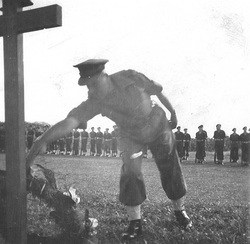
We learn from a Friends member that a campaign was mounted several years back to add the name of 22614578, Private Brian Ansell, late Suffolk Regiment, to his town war memorial at Stevenage, Hertfordshire, was rejected by the local authorities.
Brian Ansell was killed whilst on operations with 12 Platoon, D Company, 1/Suffolk, on 6th July 1952. He had been part of a patrol commanded by 2/Lt. Mike Casey, when they were ambushed in the area of the Seredah Forest Reserve in north Selangor, Malaya.
From what we understand, back in the late 1990s, Brian's sister applied to have his name added, but was informed that it could only be done at her own expense. Infuriated and outraged, she launched a local campaign with the help of the local branch of the Royal British Legion and the Hemel Hempstead branch of the Old Comrades Association, but to no avail. The council still held their ground and with that the campaign went cold.
Always keen to support a worthwhile idea, the Friends are once more investigating the possibility of have Brian's name added to the memorial. Although his name is recorded, along with the other members of The Regiment who lost their lives in Malaya at the National Memorial Arboretum, many other casualties of post-1945 conflicts, including Iraq and Afghanistan have now been added to countless war memorials across the country.
Therefore, with the passing of time and continuation of conflicts abroad, might it now be time to reinvestigate the possibility of having his name added?
We'll keep you posted.
(Posted: 12/01/2013)
Brian Ansell was killed whilst on operations with 12 Platoon, D Company, 1/Suffolk, on 6th July 1952. He had been part of a patrol commanded by 2/Lt. Mike Casey, when they were ambushed in the area of the Seredah Forest Reserve in north Selangor, Malaya.
From what we understand, back in the late 1990s, Brian's sister applied to have his name added, but was informed that it could only be done at her own expense. Infuriated and outraged, she launched a local campaign with the help of the local branch of the Royal British Legion and the Hemel Hempstead branch of the Old Comrades Association, but to no avail. The council still held their ground and with that the campaign went cold.
Always keen to support a worthwhile idea, the Friends are once more investigating the possibility of have Brian's name added to the memorial. Although his name is recorded, along with the other members of The Regiment who lost their lives in Malaya at the National Memorial Arboretum, many other casualties of post-1945 conflicts, including Iraq and Afghanistan have now been added to countless war memorials across the country.
Therefore, with the passing of time and continuation of conflicts abroad, might it now be time to reinvestigate the possibility of having his name added?
We'll keep you posted.
(Posted: 12/01/2013)
Main Picture: The wedding of Captain R.E.B. Moriarty to Miss Lois Redman at Garrison Church, Mhow, India, 1935
